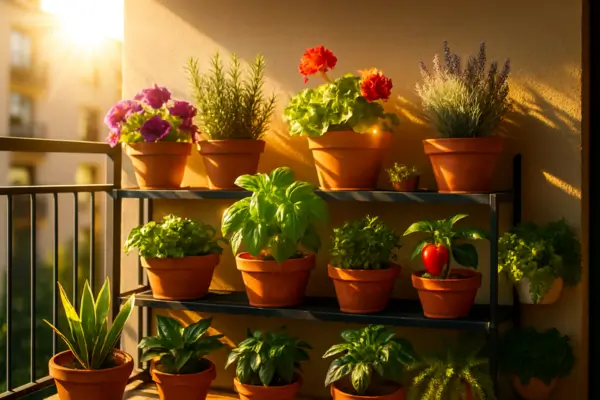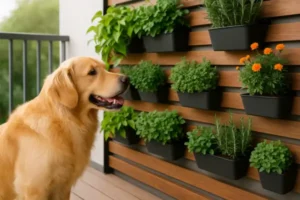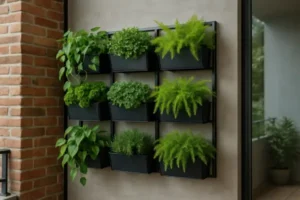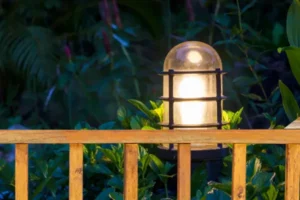Understanding how to choose plants based on sun exposure on your balcony is the secret to building a thriving, low-maintenance urban garden. It’s not just about picking your favorite flowers—sunlight tells you what will survive and what won’t.
Each balcony has its own rhythm of light and shadow. Morning sun, afternoon heat, or constant shade can dramatically change how your plants grow.
If you’re setting up a small green space—or even a modular vertical garden for gourmet balconies—making the right choices based on sun exposure means fewer headaches and more beauty year-round.
How to Choose Plants Based on Sun Exposure on Your Balcony: Step-by-Step
Understanding how to choose plants based on sun exposure on your balcony starts with one simple habit: observation. Sunlight changes throughout the day, and what looks shaded in the morning may become a hot spot in the afternoon.
How to properly read light exposure
Spend a full day watching how sunlight behaves on your balcony. Take notes or photos at different times to capture how long the light lasts and how intense it is. If possible, observe it on both sunny and cloudy days to get a balanced view.
Things to pay attention to:
- Observe your balcony in at least three time frames: morning, midday, and late afternoon
- Identify whether the sun is direct, filtered through glass or mesh, or not present at all
- Track how many hours each section receives direct light
- Watch for fixed shadows from walls, structures, or trees
- Notice how strong the light feels at different times
All of this helps you divide your balcony into light zones. And that’s exactly what will guide your decisions when planning a modular vertical garden for gourmet balconies, where different levels often receive very different amounts of sunlight.
Understanding the three types of sun exposure
Once you have a clear view of your balcony’s light pattern, you can classify each area into one of the main sun exposure categories:

- Full sun: more than 6 hours of direct sunlight per day
- Partial sun or partial shade: between 3 and 6 hours of direct sunlight
- Full shade: less than 3 hours of direct sunlight, or bright indirect light only
Most balconies don’t offer the same exposure everywhere. So when thinking about how to choose plants based on sun exposure on your balcony, you’ll need to plan plant placement based on each area’s light availability.
What to consider before choosing plants
Before heading out to buy your plants, take a moment to think through the following questions:
- How many hours of sunlight does each area receive
- Are you planting herbs, flowers, or decorative foliage
- Is your balcony exposed to strong winds or reflective heat
- How much vertical or horizontal space will the plant need as it grows
- Will you be using a structure like a modular vertical garden for gourmet balconies
Answering these questions helps you avoid frustration and gives your garden a better chance to thrive.
Organizing your plants by light requirements
Once you have mapped out the sun zones and you understand how to choose plants based on sun exposure on your balcony, the next step is to place your plants accordingly.
- Use movable pots for areas where sunlight shifts throughout the day
- Place full sun plants in the brightest spots, typically at the top of vertical structures
- Reserve shaded areas for tropical or indoor-adapted species
- In a modular vertical garden for gourmet balconies, use the upper levels for light-loving herbs and flowers, and the lower ones for shade-tolerant varieties
This kind of strategic placement helps you keep your plants healthy while maximizing visual impact.
Observe Your Balcony’s Sunlight Patterns Carefully
Learning how to choose plants based on sun exposure on your balcony means taking the time to truly understand your space. Each balcony has its own rhythm of light and shadow, shaped by direction, obstacles, and the time of year.
Track the sun like a gardener, not a tourist
Spend one full day watching how sunlight moves across your balcony. It sounds simple, but the results will surprise you. A spot that looks shady at 8 a.m. might be flooded with sun at noon. The goal here is to capture the pattern.
Ask yourself:
- Where does sunlight first appear on your balcony
- What time does direct light start, and when does it fade
- Are there shadows from trees, walls, or buildings that move as the day progresses
- Is the light gentle and indirect, or sharp and hot
To get more accurate data, repeat the observation on a sunny day and a cloudy one. Even on overcast days, light intensity can give you clues about where bright indirect light is strongest—important for shade-loving plants in a modular vertical garden for gourmet balconies.
Use simple tools to record light patterns
You don’t need any fancy equipment. Just your phone and a little attention to detail. Here’s a simple process that works:
- Use your phone’s alarm to remind you every 2 to 3 hours
- Take a photo of each section of your balcony at that time
- Jot down notes: is the light direct, filtered, or absent
- Repeat the process in both morning and afternoon
- Compare what you observe with a compass or sun-tracking app
By the end of the day, you’ll have a complete snapshot of your balcony’s sun behavior. And this becomes the blueprint for placing plants in the right zones—from full sun to full shade.
Match direction with light intensity
Each balcony orientation creates a different microclimate. Here’s what to expect based on direction:
- East-facing: Receives soft morning sun. Ideal for most herbs and leafy greens.
- West-facing: Gets strong afternoon sun, which can be intense. Choose drought-tolerant or heat-resistant plants.
- South-facing (Northern Hemisphere): Basks in sunlight most of the day. Best for fruiting plants, flowering species, and succulents.
- North-facing (Northern Hemisphere): Limited to indirect light. Perfect for ferns, pothos, and other shade-tolerant varieties.
In a modular vertical garden for gourmet balconies, this directional awareness lets you arrange each tier smartly: sun-loving herbs at the top, moisture-sensitive ferns near the bottom.
Best Plants for Full Sun Balconies
If your balcony receives more than 6 hours of direct sunlight each day, you’re working with ideal conditions. Understanding how to choose plants based on sun exposure on your balcony gives you the freedom to grow a wide range of vibrant, productive, and aromatic species that truly love the sun.
Full sun doesn’t just support growth — it energizes it. Plants in this category thrive when bathed in light and heat, often rewarding you with colorful blooms or fresh, edible harvests.
Why full sun balconies have unique potential
Sun-drenched spaces offer high visibility and strong growth potential, but they also require thoughtful plant selection. You’ll want varieties that can handle strong UV rays, high temperatures, and quicker evaporation.
A modular vertical garden for gourmet balconies with full sun exposure is perfect for culinary herbs, showy flowers, and compact fruiting plants. The key is choosing resilient species that won’t wither under intensity.
Best Plants for Partial Shade or Dappled Sunlight
Balconies with 3 to 6 hours of sunlight—or filtered light through railings or foliage—fall into this category. Think of them as “in-between” zones.
Great options include:
- Impatiens: Flower in shade or partial sun
- Caladium: Known for its colorful foliage
- Begonias: Versatile and vibrant
- Ferns: Love filtered light and humidity
- Mint and Parsley: Edible herbs that don’t need full sun
This is a common scenario in many modular vertical garden for gourmet balconies, where top plants get more light and the lower ones enjoy indirect or dappled sun.
Great plant choices for full sun balconies
Here are some reliable and beautiful performers that love the sun:
- Lavender – Fragrant and drought-tolerant, great for borders or pots
- Rosemary – Excellent for cooking and naturally ornamental
- Petunias – Bold colors and strong blooms, perfect for containers
- Geraniums – Hardy, low-maintenance, and perfect for vertical gardens
- Tomatoes – Especially cherry or patio varieties that grow well in pots
- Peppers – Sweet or hot, these thrive in heat and light with consistent watering
- Succulents – Like echeveria and sedum, ideal for upper levels of vertical setups
- Marigolds – Bright blooms that also deter pests naturally
- Oregano and Thyme – Mediterranean herbs that love heat and dry conditions
How to protect and care for full sun plants
Even sun-lovers need support to thrive on balconies. Intense light means faster evaporation and more temperature fluctuation. Without the right setup, plants can suffer.
To keep them healthy, remember:
- Choose terra cotta or light-colored pots to reduce heat buildup
- Use moisture-retaining potting soil with compost and perlite
- Water early in the morning to avoid scorching leaves during peak sun
- Mulch the soil surface to prevent water loss
- Add drip irrigation or self-watering systems for consistent care
- Rotate pots occasionally to encourage even growth
When placed in a modular vertical garden for gourmet balconies, keep these sun-demanding plants at the top tier where they’ll get the longest exposure and best drainage.
Plants That Thrive in Full Shade
Balconies with less than three hours of direct sun per day may seem limiting at first glance, but they actually open up a whole new world of lush, low-light plant choices. Knowing how to choose plants based on sun exposure on your balcony helps you uncover beautiful species that don’t just survive in shade—they thrive in it.
Shade doesn’t mean dull. In fact, many shade-tolerant plants offer dramatic foliage, rich textures, and surprising air-purifying benefits. They’re perfect for cooler, darker spots, especially if you’re working with a modular vertical garden for gourmet balconies, where lower rows often stay protected from intense sun.
What makes a good shade plant
Shade-loving plants are naturally adapted to forest floors or understory environments. That means they prefer soft, indirect light or brief moments of dappled sun. They also tend to need less water due to slower evaporation.
These plants are ideal for:
- North-facing balconies (in the Northern Hemisphere)
- Corners blocked by walls, overhangs, or neighboring buildings
- The bottom tiers of vertical gardens
- Indoor-outdoor transitions where lighting is mild
They don’t just tolerate low light — many will fade or burn in too much sun, making them perfectly suited for your least exposed areas.
Great plants for shady balconies
Here are some reliable species that flourish in shade and low-light conditions:
- Snake Plant – Known for its upright, sword-like leaves and extreme tolerance
- ZZ Plant – Glossy green foliage that thrives on neglect and limited light
- Pothos – Trailing vines that grow quickly even in indirect light
- Peace Lily – Elegant white blooms with dark leaves, excellent for air quality
- Chinese Evergreen – Beautifully patterned leaves that brighten up dim spaces
- Cast Iron Plant (Aspidistra) – As tough as its name suggests, great for deep shade
- Philodendron – Adaptable, with many varieties for vertical and container gardening
How to care for shade-loving plants on your balcony
Even though they don’t crave sunlight, these plants still need attention to stay healthy and attractive.
Keep them at their best with these tips:
- Avoid overwatering — shade slows down evaporation
- Use well-draining soil to prevent root rot
- Wipe leaves regularly to remove dust and enhance photosynthesis
- Keep pots away from cold drafts or areas with poor airflow
- Fertilize lightly during warmer months for steady growth
In a modular vertical garden for gourmet balconies, place these plants on the lower levels where they’ll be naturally protected by upper tiers. They also help add contrast and softness to the base of your green wall.
Match Plants to Position in a Modular Vertical Garden
Positioning is everything when planning a modular vertical garden for gourmet balconies. Each level receives a different amount of light, so placing the right plants in the right tier ensures a balanced and thriving setup.
- Top rows get the most direct sunlight. Ideal for sun-hungry herbs like basil, compact vegetables, flowering plants such as petunias, or succulents that love heat and dryness.
- Middle rows receive moderate, filtered light. This is where you can grow plants like oregano, parsley, or begonias that prefer partial sun and slightly cooler conditions.
- Lower rows stay naturally shaded. Perfect for moisture-loving and shade-adapted species like ferns, ivy, or peace lilies that flourish in lower light levels.
This smart layering eliminates the need to constantly move containers. Instead, your garden stays organized, attractive, and efficient.
Most vertical systems include racks with adjustable slots, fabric pockets, or clip-on containers. These make it easy to reposition plants seasonally, replace tired growth, or experiment with new combinations—all without disrupting the structure.
Understanding how to choose plants based on sun exposure on your balcony is what transforms a simple vertical setup into a personalized growing system that fits your light, your lifestyle, and your taste.
Tips for Choosing the Right Containers
Choosing the right container is just as important as choosing the right plant. When thinking about how to choose plants based on sun exposure on your balcony, you also need to consider how containers react to light, heat, and moisture.
On a balcony, conditions can change fast. Sun-facing areas heat up quickly. Shaded spots may stay damp for longer. That’s why container material, size, and design matter—especially in a modular vertical garden for gourmet balconies, where every level has its own microclimate.
A few practical container tips
- Use light-colored pots in hot areas to avoid overheating
- Choose self-watering containers for sun-drenched balconies
- Always check for drainage holes to protect roots
- Use vertical pockets for plants like ferns that grow well in shade
- Try fabric planters to improve airflow and root health
When the container matches the plant’s environment, you’ll spend less time troubleshooting and more time enjoying a thriving, low-maintenance garden.
Other Factors That Affect Balcony Plant Growth
When learning how to choose plants based on sun exposure on your balcony, it’s important to remember that sunlight is just one piece of the puzzle. Your balcony’s microclimate is shaped by several other elements that can help or hinder plant growth—especially in compact spaces or when using a modular vertical garden for gourmet balconies.
Wind can be a hidden stressor
Upper-floor balconies or those exposed to open surroundings tend to be windier than expected. Strong gusts can dry out soil faster, damage delicate leaves, or even topple lightweight pots.
What helps:
- Install windbreaks like bamboo panels or vertical trellises
- Group plants together to create a natural buffer
- Place heavier containers at the base of your setup for added stability
Heat from surfaces builds up quickly
Direct sun is one thing, but reflected heat from metal railings, concrete floors, or glass walls can stress plants even further. This often causes wilting or uneven growth, especially in summer.
What helps:
- Avoid placing pots directly against metal or hot walls
- Use insulating pot bases or plant stands to lift containers slightly
- Choose heat-tolerant plants for spots exposed to long hours of intense sun
Humidity levels shape plant success
Humidity can make or break your garden. Tropical plants like ferns and calatheas love high moisture in the air. On the other hand, succulents, rosemary, and lavender prefer drier conditions.
What helps:
- For humid balconies, choose plants that thrive in moisture-rich air
- For dry climates, add a shallow tray with pebbles and water under pots to gently increase humidity
- Use misting sparingly to support shade-loving species without overwatering
Common Balcony Orientations and What They Mean
Here’s a quick guide based on which direction your balcony faces:
| Orientation | Sunlight Type | Best Plant Types |
|---|---|---|
| East-facing | Morning sun, cooler | Herbs, lettuce, begonias |
| West-facing | Hot afternoon sun | Lavender, rosemary, succulents |
| South-facing (NH) | Full sun most of the day | Tomatoes, peppers, flowering annuals |
| North-facing (NH) | Indirect or full shade | Ferns, snake plants, ZZ plant |
Remember: balconies in the Southern Hemisphere have the opposite sun exposure. South-facing is shade, and north-facing is sun.
Balcony Gardening Tools That Make a Difference
When setting up your green space, having the right tools can make everything easier. Whether you’re just starting or already know how to choose plants based on sun exposure on your balcony, a few smart additions help you care for your plants with less effort.
Simple tools, big results
- Moisture meters help you check if the soil is too dry or too wet
- Grow lights are ideal for shaded corners or balconies with limited sun
- Automatic timers keep watering schedules consistent, especially in modular vertical garden for gourmet balconies
- Wheeled plant stands let you adjust plant positions with ease
- UV-resistant planters protect containers from fading or cracking under strong sun
These small investments bring more control, reduce mistakes, and let you enjoy your garden even if you’re short on time.
Frequently Asked Questions (FAQ)
To help you apply everything you’ve learned about how to choose plants based on sun exposure on your balcony, here are some common questions people ask when setting up their space.
What plants are best for a shady balcony?
Snake plants, pothos, ZZ plants, peace lilies, and ferns all thrive in low light or bright indirect light. They’re perfect for the cooler corners of your setup.
Can I grow vegetables on a sunny balcony?
Yes. If you have 6 or more hours of direct sunlight, vegetables like tomatoes, peppers, lettuce, and compact herbs will do very well.
How do I know how much sunlight my balcony gets?
Track it manually on a sunny day by noting when the light hits and when it fades. Or use an app like Sun Surveyor or Sun Seeker for more precision.
What is the best soil for balcony plants?
A light, well-draining potting mix is best. For vertical setups, add perlite or coconut coir to balance drainage and water retention—especially in a modular vertical garden for gourmet balconies.
Is it possible to have a green wall in a small apartment?
Absolutely. Modular systems are designed to fit compact balconies and indoor walls, making it easy to create a vertical garden in tight spaces.
How often should I water balcony plants?
It depends on plant type and sunlight exposure. Full sun areas may need daily watering, while shaded sections typically require less frequent care.
A Balcony Garden That Works for You
Every balcony holds unique potential, and it all starts with understanding how to choose plants based on sun exposure on your balcony. With that clarity, your garden begins to grow with ease and confidence.
Noticing the light, placing each plant in the right spot, and working with your space’s rhythm turns care into something simple and enjoyable. Everything flows more naturally.
And when you use a modular vertical garden for gourmet balconies, it all comes together beautifully. You make the most of your space—with structure, greenery, and a touch of life that lifts the entire setting.




